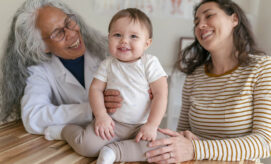Although separation anxiety is a very normal part of child development, it is still stressful… for children, parents, and caregivers. When children feel sad or anxious, it is important for us to have a clear understanding of what is going on in order to properly support their needs. With this understanding, we can create a plan with children and their parents that supports each child’s individual transition process.
The Link between Individual Development and Separation
Separation anxiety is common, but each child’s experience of anxiety is unique. Children go through developmental stages at different rates, and some children have a more difficult time with separation than others.
For Infants
According to the American Academy of Pediatrics, separation anxiety develops after a child gains an understanding of object permanence (meaning that items still exist, even when they cannot be seen). While some children develop this understanding early, typically children will begin to show signs of separation anxiety around 9 months.
For Toddlers
Toddlerhood is often the peak of separation anxiety. American Academy of Pediatrics reminds us that “Separations are more difficult when children are hungry, tired, or sick—which describes most of toddlerhood! As children develop independence during toddlerhood, they may become even more aware of separations. Their behaviors at separations will be loud, tearful, and difficult to stop.”
For Preschool-aged Children
BabyCenter explains that children typically grow out of separation anxiety around their third birthday. While you may still see temporary episodes from time to time, these typically occur during new transitions, as in the case of a new center or new caregiver.
How to Help Parents
When children are upset their parents are also likely to experience anxiety. No parent wants to see her child feeling sad, and leaving a child in that state can lead to feelings of guilt.
Be sure to remind parents that separation anxiety is temporary, and that it will eventually pass. Kids Health reminds us that if a child has never been cared for by anyone but parents, it is completely natural for them to worry when seeing parents leave. Some children, depending on personality or temperament, might struggle more than others.
Tips for Parents
American Academy of Pediatrics offers several tips that you can share with parents who have trouble handling these goodbyes. Some of their recommendations include:
-
Create quick and consistent goodbye routines: When parents linger, the goodbye process gets dragged out and children feel more anxious. It is best to be quick and to follow through, even if the child begins to cry or get upset. Consistency helps children establish a routine with parents so that they know what to expect. Encourage parents to do the same thing each day at drop-off, whether it is a goodbye song or a special hug.
-
Talk to children using easy-to-understand specifics: AAP recommends that parents describe when they are going to return using phrases such as, “I’ll be back after nap time and before afternoon snack.”
-
Keep promises: When parents tell their children that they are leaving, it is important that they stick to the plan. Although we always want parents to feel welcome in the classroom, remind them that coming back to visit can be confusing, and will often require going through the transition process all over again.





